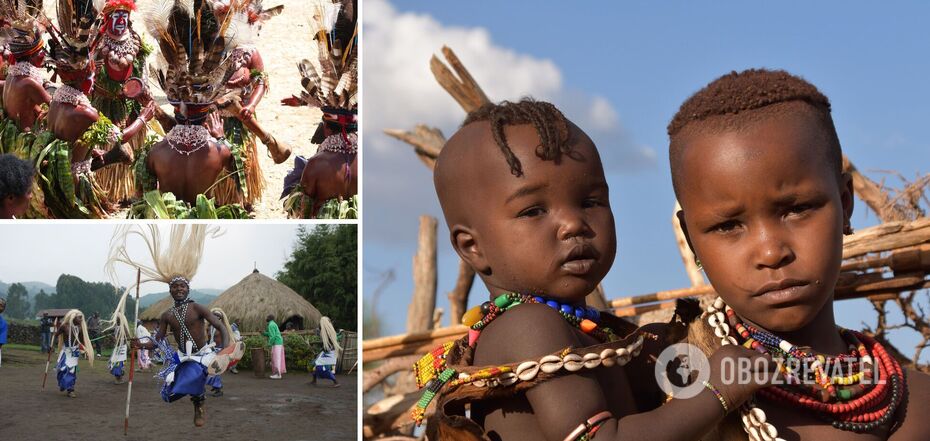Life
Despite civilization: where wild tribes still live, some are willing to kill foreigners
Cities are being built, people are going into space, Elon Musk is approaching the colonization of Mars. And in the meantime, wild tribal peoples who do not recognize the gifts of civilization still live in different parts of the planet. Some of them are friendly, others are ready to kill any stranger. The most colorful of them in the selection of OBOZREVATEL.
Himbo (Namibia).
This semi-nomadic tribe has lived among the deserts of Namibia for hundreds of years. They are quite friendly and do not show any aggression unnecessarily. Tourists, explorers and photographers can find common ground with these people with the help of local guides. The inhabitants of the settlements are happy to welcome new guests. At the same time, the rules and customs of the Himba have not changed for several centuries. Here they still sew their own clothes, marry by marriage of convenience and obey the chief. Telephones, electricity, or other benefits of civilization are not recognized here.
{"imgSrc": "https://i.obozrevatel.com/gallery/2022/1/17/himba-g721b8b0ca1920.jpg", "imgWidth":1920, "imgHeight":1280, "title": "These people live in the desert.", "sourceTxt": "pixabay.com", "alt":"\n\n"}
Bayaka (Congo).
For most scientists, these tribes exist under the name Pygmies. However, the inhabitants of the jungle themselves call themselves the bayaks. They are a wild but very friendly people who have spent many centuries among the dense forests. It is here that they feel absolutely safe. They eat what they can catch or find. These are small and large animals, berries, leaves. They get their medicine by the same method. Tourists rarely see them, because they are incredibly good at hiding among the greenery. However, guides give tours and acquaint foreigners with the customs of these people. They are not afraid of visitors, so they do not attack them.
However, it should be noted that the Pygmies have changed their life a little in recent years. They have started buying clothes and sometimes come to the nearest villages for food and things. They earn their money mainly from tourists by conducting rituals and arranging entertainment programs. It is very easy to distinguish the Basnians from the other inhabitants of the Congo - they are distinguished by their rather short stature. This is one of the reasons why the tribes are so interesting to researchers.
{"imgSrc": "https://i.obozrevatel.com/gallery/2022/1/17/show-gf29fb23f01920.jpg", "imgWidth":1920, "imgHeight":1280, "title": "They live in the middle of the jungle.", "sourceTxt": "pixabay.com", "alt":"\n\n"}
Chimbu (New Guinea).
For these people the encounter with civilization was a huge shock. The inhabitants of the remote regions of Papua had not encountered modern humans before 1980. They ate what they could find, sewed clothes from animal skins, and lived in small houses made from tree branches and leaves. However, New Guinea at the end of the twentieth century began to grow rapidly and the wild people had to constantly look for a new place. The life of the Chimbu also changed. Because of the destruction of forests, they had to earn money for food. They do this with the help of tourists, for whom they conduct a rite of spirits, painting themselves as skeletons.
{"imgSrc": "https://i.obozrevatel.com/gallery/2022/1/17/canoe-g8b12412f21920.jpg", "imgWidth":1920, "imgHeight":1440, "title": "The Chimbu are friendly to tourists.", "sourceTxt": "pixabay.com", "alt":"\n\n"}
Huli (New Guinea).
Papua's largest tribal people already number more than 150,000. It has its own primitive political and economic systems, clan divisions and state structure. At the same time Hulians are very persistent in communicating with other people and even take part in the life of New Guinea. They perform at festivals, give tours, speak several local languages fluently.
This tribe does not completely abandon the benefits of living in civilization. Here you can see the usual clothes, food from supermarkets and even comfortable mattresses. At the same time, Papuans do not betray the old traditions of their people and the old rules.
{"imgSrc": "https://i.obozrevatel.com/gallery/2022/1/17/highlands-g9d0f84a201920.jpg", "imgWidth":1920, "imgHeight":1280, "title": "Huli are active in the country.", "sourceTxt": "pixabay.com", "alt":"\n\n"}
Dogon (Male).
The indigenous tribes of the Dogon inhabit the western part of Africa. Interestingly, this area is very attractive to historians. Here in the mountains you can find unique wall paintings. Some of the paintings date back to the 13th-14th centuries. They depicted not only the ordinary processes of local life, but also astronomical calculations and maps. Now, however, these tribes have lost their influence. They live apart from the people, making money from excursions and the sale of souvenirs.
{"imgSrc": "https://i.obozrevatel.com/gallery/2022/1/17/rwanda-gacd3109f31920.jpg", "imgWidth":1920, "imgHeight":1441, "title": "Dogons make good money from tourists.", "sourceTxt": "pixabay.com", "alt":"\n\n"}
Previously OBOZREVATEL wrote about an interesting vacation on the paradise island of Zanzibar.



























